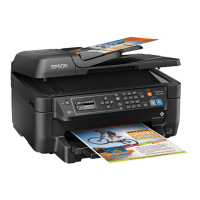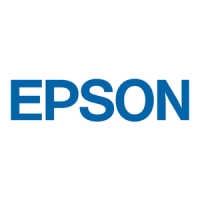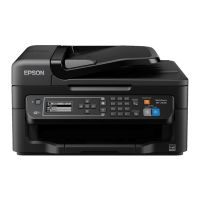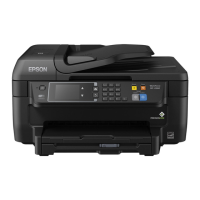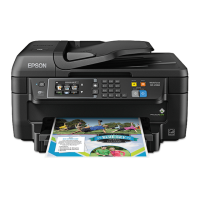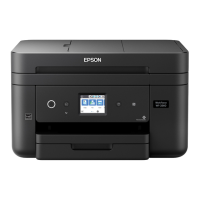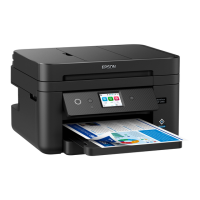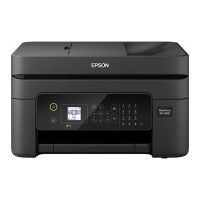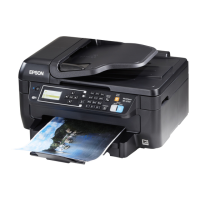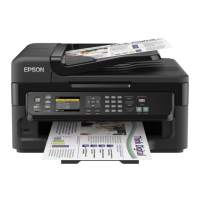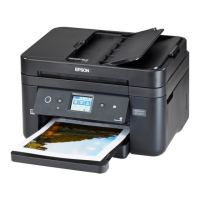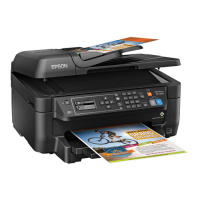
Do you have a question about the Epson WF-2650 and is the answer not in the manual?
| Print Technology | Inkjet |
|---|---|
| Scan Resolution | 1200 x 2400 dpi |
| Fax | Yes |
| Automatic Document Feeder | Yes, 30 sheets |
| Scanner Type | Flatbed |
| Copy Resolution | 600 x 600 dpi |
| Fax Speed | 33.6 Kbps |
| Connectivity | Wi-Fi, Wi-Fi Direct, USB, Ethernet |
| Duplex Printing | Yes |
| Paper Capacity | 150 sheets |
| Mobile Printing | Epson Connect, Apple AirPrint, Google Cloud Print |
| Print Speed (Black) | 13 ISO ppm |
| Print Speed (Color) | 7.3 ISO ppm |
| Weight | 14.6 lbs |
| Print Resolution | 4800 x 1200 dpi |
| Display | 2.2-inch mono LCD |
Learn about the control panel and select control panel settings.
Details about buttons and indicator lights on the control panel.
Understand the meaning of status icons displayed on the LCD screen.
Guidelines for inputting characters for passwords and other settings.
How to change the language used on the LCD screen.
Procedure to disable sounds from control panel button presses.
How to adjust the contrast of the LCD screen.
Identify the physical parts of your product.
Details of the top and front components of the product.
Details of the paper path components within the product.
Details of the internal components of the product.
Details of the rear components of the product.
Configure sleep mode and other settings to save energy and resources.
Procedure to adjust the product's eco settings.
Adjust the time before the product enters sleep mode.
Set the time for the product to automatically turn off.
Use Epson Connect services for remote printing and scanning.
Print documents by sending them via email to the product.
Print and scan using the Epson iPrint mobile application.
Print to Epson products remotely using the Remote Print software.
Send scanned files to a cloud destination.
Print wirelessly from Apple iOS devices and Macs.
Print from various devices using Google Cloud Print.
Guide to setting up Google Cloud Print on a Chromebook.
Set up communication via a wireless router or access point.
Configure wireless network settings using the product's control panel.
Set up direct communication without a router.
Activate Wi-Fi Direct for direct device communication.
Connect to a WPS-enabled network quickly.
Use WPS to connect your product to the network.
Print a sheet to help diagnose network problems.
Modify or update how the product connects to a network.
Access product network settings via a web browser.
Switch from USB to a wireless connection.
Update product connection for a new wireless router.
Turn off the product's Wi-Fi capabilities.
Load document paper into the paper cassette.
Load photo paper into the paper cassette.
Load envelopes into the paper cassette.
Information on the paper capacity of the cassette.
List of compatible Epson paper types.
Compatible paper types and sizes for borderless printing.
Select appropriate settings for different paper types.
Change default paper size and type via control panel.
Configure settings for paper sources used in print jobs.
Adjust default universal print settings from the control panel.
How to place originals on the scanner glass.
How to place originals in the automatic document feeder.
Step-by-step guide to copying documents and photos.
Select the paper size for copying jobs.
Customize various options for copying.
Detailed printing procedures for Windows users.
Select fundamental settings for printing documents or photos.
Configure settings for double-sided printing.
Customize layout and other print options.
Use predefined print settings for quick access.
Access and configure advanced print settings.
Final steps to save settings and start printing.
Set default print settings for all Windows applications.
Change the language of the Windows printer software interface.
Configure automatic software update settings.
Detailed printing procedures for OS X users.
Select fundamental settings for printing documents or photos.
Configure page setup options for printing.
Customize layout options for printing.
Configure settings for double-sided printing.
Adjust color matching and options for printouts.
Set printing preferences that apply to all print jobs.
Final steps to print documents or photos on OS X.
Monitor print job progress and ink status on OS X.
Cancel a print job using a button on the product.
Begin the scanning process.
Initiate a scan using the product's control panel buttons.
Launch Epson Scan from the software icon.
Initiate a scan from an external scanning application.
Customize scan settings in various modes.
Choose between different scan modes like Office and Professional.
Select the desired scan mode from the Epson Scan window.
Scan documents using Office Mode settings for PDF output.
Options for selecting the document source in Office Mode.
Define the specific area to scan in Office Mode.
Select image adjustment options available in Office Mode.
Scan documents using Professional Mode for advanced customization.
Options for selecting document source in Professional Mode.
Select image types for scanning in Professional Mode.
Define the scan area in Professional Mode.
Guidelines for previewing scanned images.
Recommendations for selecting scan resolution based on usage.
Choose location, name, and format for scanned files.
Scan using Image Capture on OS X.
Select scan settings for Image Capture on OS X.
Connect a phone or answering machine for faxing.
Configure fax header and features.
Configure fax settings via the product's control panel.
Set the country or region for fax settings.
Set the current date, time, and daylight saving phase.
Use the wizard to set up basic fax settings.
Configure the line type for fax connections.
Set how many rings before the product answers a fax.
Adjust advanced settings for sending, receiving, and printing faxes.
Set basic options for incoming and outgoing faxes.
Configure options for receiving faxes.
Set security options for fax data.
Print various fax reports for diagnostics.
Configure fax settings using the FAX Utility for Windows.
Configure fax settings using the FAX Utility for OS X.
Create lists of contacts and groups for easier faxing.
Manage contacts and groups via the product control panel.
Add a new contact to the list for faxing.
Modify or remove existing contacts from the list.
Create groups of contacts for sending faxes to multiple recipients.
Modify or remove existing contact groups.
Manage speed dial and group lists via Windows FAX Utility.
Manage speed dial and group lists via OS X FAX Utility.
Instructions for sending faxes using the product.
Send faxes using the product's control panel.
Step-by-step guide to faxing directly from the control panel.
Configure settings for sending faxes.
Send faxes by dialing from a connected telephone.
Schedule faxes to be sent at a later time.
Send faxes using the FAX Utility for Windows.
Send faxes using the FAX Utility for OS X.
Instructions for receiving faxes with the product.
Understand how the product receives faxes.
Set the product to automatically receive and print faxes.
Receive faxes manually by checking for a fax tone.
Receive faxes from another machine using polling.
Check the current status of ink cartridges.
Check ink levels using the product's LCD screen.
Check ink status using the Windows utility.
Check ink status using the OS X utility.
Information on where to buy genuine Epson ink cartridges.
Part numbers for ordering new ink cartridges.
Step-by-step guide for cartridge replacement.
Perform maintenance on the print head.
Check for clogged nozzles in the print head.
Clean the print head nozzles to improve print quality.
Align the print head to correct print quality issues.
Clean the paper path to remove excess ink.
Steps for cleaning the product's exterior and interior.
Prepare the product for storage or transportation.
Check for and install the latest product software updates.
Diagnose problems by checking LCD screen messages.
Perform a product check to verify its operating status.
Reset control panel settings to factory defaults.
Resolve issues encountered during product setup.
Troubleshoot problems with network setup or usage.
Resolve issues connecting to a wireless router or access point.
Troubleshoot issues where network software cannot find the product.
Resolve issues with the product not appearing in the OS X printer window.
Troubleshoot problems preventing printing over a network.
Troubleshoot issues preventing scanning over a network.
Resolve issues related to copying functions.
Address noise issues without copying occurring.
Troubleshoot issues related to paper feeding and jamming.
Resolve issues with paper not feeding correctly.
Clear paper jams that occur inside the product.
Clear paper jams within the paper cassette.
Clear paper jams in the duplexer (rear cover).
Clear document jams from the automatic document feeder.
Resolve issues with paper not ejecting properly.
Resolve issues when printing from a computer.
Troubleshoot situations where no printing occurs.
Resolve issues with the product icon not showing in the Windows taskbar.
Troubleshoot errors that appear after replacing an ink cartridge.
Address issues causing slow printing performance.
Troubleshoot issues with printed page layout and content.
Resolve issues where the printed image is inverted.
Address issues where too many copies are printed.
Troubleshoot unexpected blank pages in printouts.
Resolve issues with incorrect print margins.
Troubleshoot borders appearing on borderless prints.
Resolve issues with incorrect characters appearing in prints.
Correct issues with printed image size or position.
Troubleshoot slanted printouts.
Address issues affecting the quality of printouts.
Resolve white or dark lines (banding) in printouts.
Troubleshoot blurry or smeared printouts.
Address faint printouts or printouts with gaps.
Troubleshoot grainy printouts.
Resolve issues with incorrect colors in printouts.
Troubleshoot issues encountered during scanning.
Resolve issues with scanning software not functioning properly.
Troubleshoot issues preventing Epson Scan from starting.
Resolve quality issues with scanned images.
Troubleshoot scanned images with only a few dots.
Address lines of dots appearing in all scanned images.
Resolve issues with straight lines appearing crooked in scanned images.
Troubleshoot distorted or blurry scanned images.
Address patchy color issues at the edges of scanned images.
Troubleshoot scanned images that appear too dark.
Troubleshoot issues related to faxing functions.
Resolve issues with sending or receiving faxes.
Troubleshoot receiving faxes when a telephone is connected.
Guidance on when to uninstall and reinstall software.
Information on how to contact Epson for support.
Specifies the minimum Microsoft operating systems required for the product.
Specifies the required Mac operating systems for the product.
Details about the product's scanning capabilities.
Technical specifications for the automatic document feeder.
Technical specifications related to the fax functionality.
Details about paper types and weights supported.
Information on the printable area for different paper types.
Specifications related to the ink cartridges used by the product.
Physical dimensions of the product.
Electrical requirements for the product.
Operating and storage environmental conditions.
Specifications for the product's interface ports.
Details about the wireless and wired network connections.
Safety certifications and regulatory compliance information.
Critical safety instructions for using the product.
General safety guidelines for using the Epson product.
Safety precautions specific to handling ink cartridges.
Safety guidelines for wireless network connections.
Safety precautions for telephone equipment usage.
Safety guidelines for interacting with the LCD screen.
Regulatory statement regarding FCC compliance.
Notices related to the included software programs.
List of trademarks associated with the product and company.
Legal notice regarding the publication's copyright.
Acknowledgment for libTIFF software used in the product.
Encourages responsible use of copyrighted materials.
Information on sleep mode and energy saving settings.
